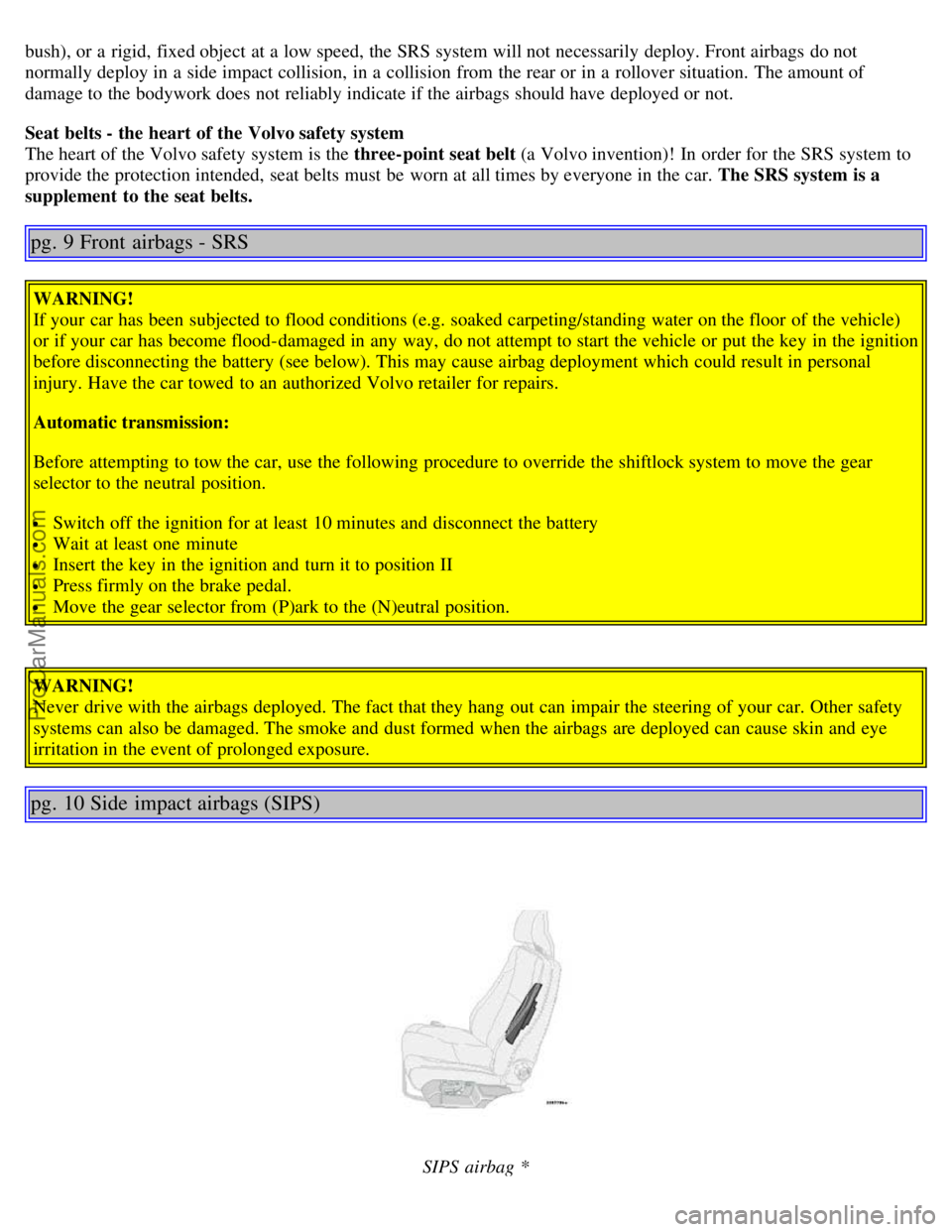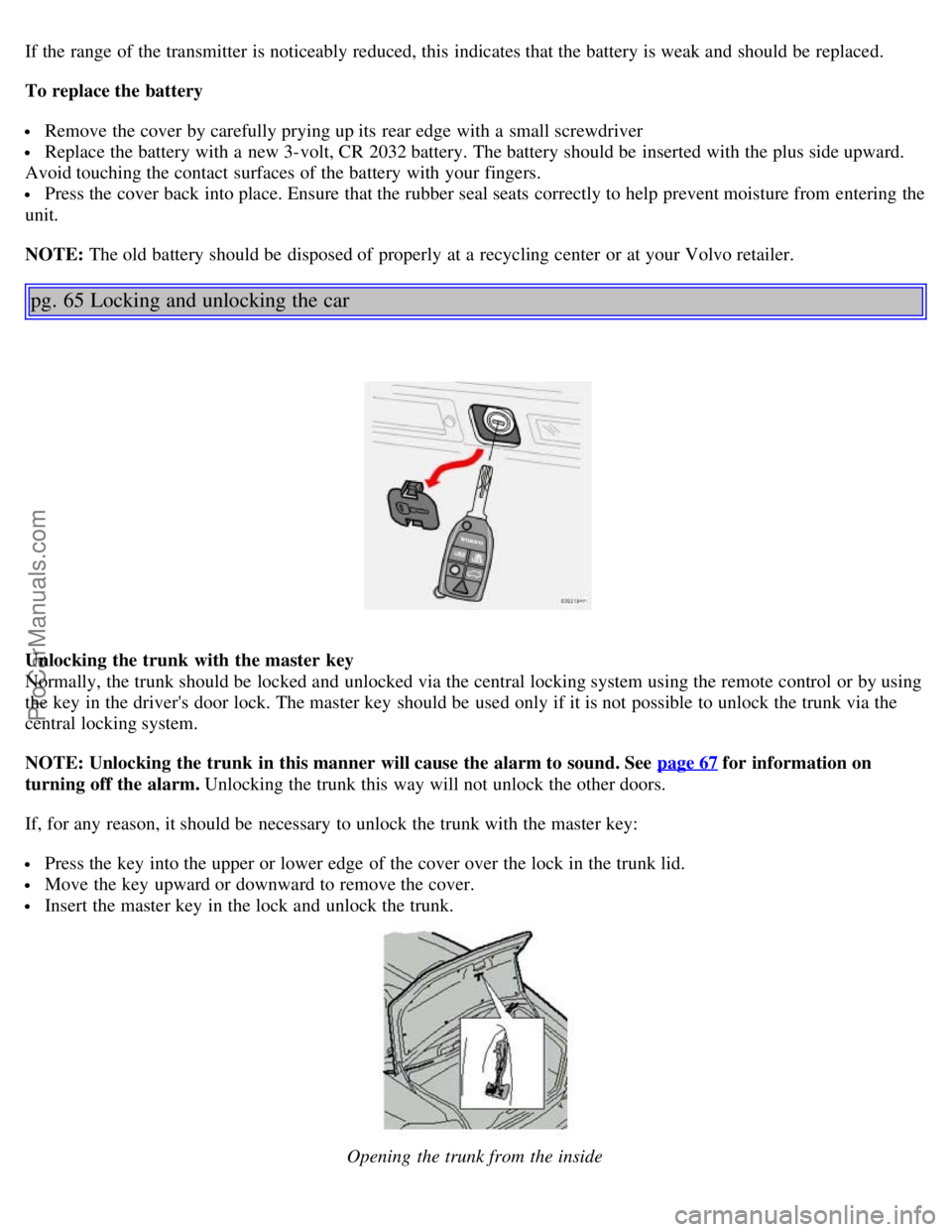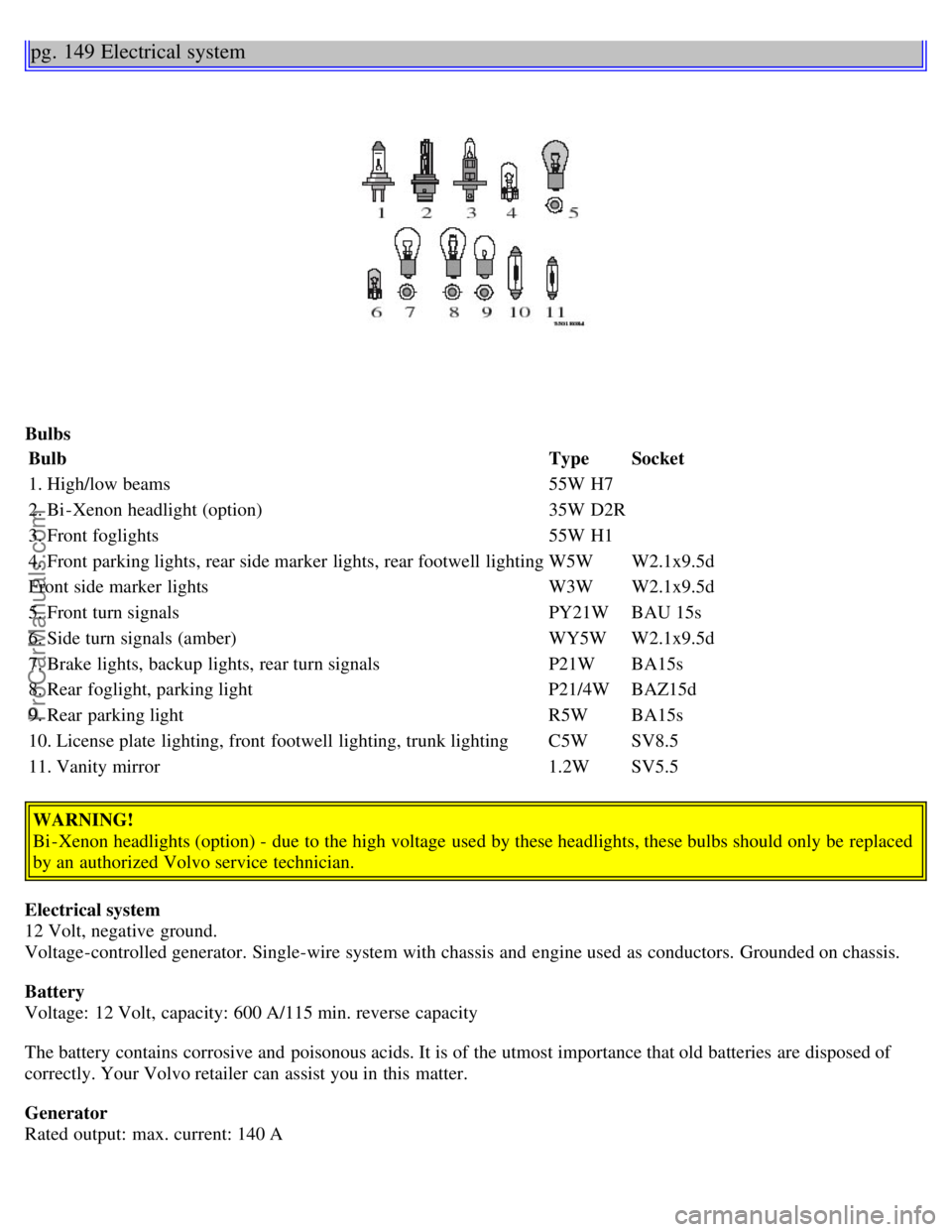2005 VOLVO S80 battery
[x] Cancel search: batteryPage 12 of 123

bush), or a rigid, fixed object at a low speed, the SRS system will not necessarily deploy. Front airbags do not
normally deploy in a side impact collision, in a collision from the rear or in a rollover situation. The amount of
damage to the bodywork does not reliably indicate if the airbags should have deployed or not.
Seat belts - the heart of the Volvo safety system
The heart of the Volvo safety system is the three-point seat belt (a Volvo invention)! In order for the SRS system to
provide the protection intended, seat belts must be worn at all times by everyone in the car. The SRS system is a
supplement to the seat belts.
pg. 9 Front airbags - SRS
WARNING!
If your car has been subjected to flood conditions (e.g. soaked carpeting/standing water on the floor of the vehicle)
or if your car has become flood-damaged in any way, do not attempt to start the vehicle or put the key in the ignition
before disconnecting the battery (see below). This may cause airbag deployment which could result in personal
injury. Have the car towed to an authorized Volvo retailer for repairs.
Automatic transmission:
Before attempting to tow the car, use the following procedure to override the shiftlock system to move the gear
selector to the neutral position.
Switch off the ignition for at least 10 minutes and disconnect the battery
Wait at least one minute
Insert the key in the ignition and turn it to position II
Press firmly on the brake pedal.
Move the gear selector from (P)ark to the (N)eutral position.
WARNING!
Never drive with the airbags deployed. The fact that they hang out can impair the steering of your car. Other safety
systems can also be damaged. The smoke and dust formed when the airbags are deployed can cause skin and eye
irritation in the event of prolonged exposure.
pg. 10 Side impact airbags (SIPS)
SIPS airbag *
ProCarManuals.com
Page 13 of 123

SIPS airbag (front seats only)
As an enhancement to the structural Side Impact Protection System built into your car, the car is also equipped with
Side Impact Protection System (SIPS) airbags. The SIPS airbag system consists of airbag modules built into the sides
of both front seat backrests (1), wires (2) and gas generators/sensor units (3).
The SIPS airbag system is designed to help increase occupant protection in the event of certain side impact collisions.
The SIPS airbags are designed to deploy only during certain side-impact collisions, depending on the crash severity,
angle, speed and point of impact. The airbags are not designed to deploy in all side impact situations.
NOTE: SIPS airbag deployment (one airbag) occurs only on the side of the vehicle affected by the impact.
WARNING!
The SIPS airbag system is a supplement to the Side Impact Protection System and the three-point seat belt system.
It is not designed to deploy during collisions from the front or rear of the car or in rollover situations.
The use of seat covers on the front seats may impede SIPS airbag deployment.
No objects, accessory equipment or stickers may be placed on, attached to or installed near, the SIPS airbag
system or in the area affected by SIPS airbag deployment (see illustration below).
Never try to open or repair any components of the SIPS airbag system. This should only be done by an authorized
Volvo service technician.
In order for the SIPS airbag to provide its best protection, both front seat occupants should sit in an upright
position with the seat belt properly fastened.
1 - Airbag, 2 - wire, 3 - gas generator/sensor unit
WARNING!
Never drive with the airbags deployed. The fact that they hang out can impair the steering of your car. Other
safety systems can also be damaged. The smoke and dust formed when the airbags are deployed can cause skin and
eye irritation in the event of prolonged exposure.
If your car has been subjected to flood conditions (e.g. soaked carpeting/standing water on the floor of the
vehicle) or if your car has become flood-damaged in any way, do not attempt to start the vehicle or put the key in
the ignition before disconnecting the battery. This may cause airbag deployment which could result in personal
injury. Have the car towed to an authorized Volvo retailer for repairs.
*A SIPS airbag warning decal is also located at the end of the instrument panel on the driver's side of the car.
pg. 11 Volvo Inflatable curtain (VIC)
ProCarManuals.com
Page 45 of 123

If the range of the transmitter is noticeably reduced, this indicates that the battery is weak and should be replaced.
To replace the battery
Remove the cover by carefully prying up its rear edge with a small screwdriver
Replace the battery with a new 3-volt, CR 2032 battery. The battery should be inserted with the plus side upward.
Avoid touching the contact surfaces of the battery with your fingers.
Press the cover back into place. Ensure that the rubber seal seats correctly to help prevent moisture from entering the
unit.
NOTE: The old battery should be disposed of properly at a recycling center or at your Volvo retailer.
pg. 65 Locking and unlocking the car
Unlocking the trunk with the master key
Normally, the trunk should be locked and unlocked via the central locking system using the remote control or by using
the key in the driver's door lock. The master key should be used only if it is not possible to unlock the trunk via the
central locking system.
NOTE: Unlocking the trunk in this manner will cause the alarm to sound. See page 67
for information on
turning off the alarm. Unlocking the trunk this way will not unlock the other doors.
If, for any reason, it should be necessary to unlock the trunk with the master key:
Press the key into the upper or lower edge of the cover over the lock in the trunk lid.
Move the key upward or downward to remove the cover.
Insert the master key in the lock and unlock the trunk.
Opening the trunk from the inside
ProCarManuals.com
Page 47 of 123

Valet security locking
The security locking feature of your car allow you to prevent unwanted access to your trunk and glove compartment,
while still allowing a parking attendant to unlock, start, and relock the rest of your car. To prevent unwanted access to
the trunk and glove compartment do the following:
Give your service key to the parking attendant.
Insert your master key into the glove compartment. Turn it 90 degrees clockwise and remove the key. The glove
compartment cannot be unlocked with the service key.
Insert your master key into the ignition and turn it to position II.
Press the trunk lock button in the center console. An LED and a message in the text window will show that the trunk
lock has be activated.
Turn off the ignition and remove the master key.
With the trunk lock activated, neither the service key nor the remote control will open the trunk.
The function can be turned off (deactivated) by turning the ignition key to position II and pressing the trunk lock
button again (the LED in the button will go out and VALET LOCK OFF" will be displayed in the text window).
* The position of this button may vary, depending on the specifications of your car.
pg. 67 Alarm
Alarm
The alarm is automatically armed whenever you lock your car.
When armed, the alarm continuously monitors a number of points on the car. The following conditions will set off the
alarm:
The hood is forced opened.
The trunk is forced opened.
A door is forced opened.
The ignition switch is tampered with.
If there is movement in the passenger compartment (if the car is equipped with the optional movement sensor).
The car is lifted or towed (if the car is equipped with the optional inclination sensor).
The battery is disconnected (while the alarm is set).
Arming the alarm
Press the LOCK button on the remote control, lock the car using the key in the driver's door or press the central lock
button on one of the front doors with the door open. One long flash of the turn signals will confirm that the alarm is
armed.
Disarming the alarm
Press the UNLOCK button on the remote control or unlock the doors with the key.
Turning off (stopping) the alarm
If the alarm is sounding, it can be stopped by pressing the UNLOCK button on the remote control or by unlocking the
driver's door with the key.
Visual alarm signal
The visual alarm signal is given by flashing all turn signals and turning on the interior lighting for approximately 5
minutes.
Audible alarm signal
An audible alarm signal is given by a battery powered siren. One alarm cycle lasts for 25 seconds.
ProCarManuals.com
Page 79 of 123

2 0 0 5
VOLVO S80
Chapter 8 - Maintenance/Servicing
pg. 113 Maintenance/Servicing
Fuses114
Replacing bulbs119
Paint touch up126
Washing the car127
Cleaning the upholstery129
Maintenance service, Warranty130
Fuel/emissions systems131
Drive belt, Coolant132
Emissions maintenance133
Washer fluid, Hoisting the car134
Opening the hood, Engine compartment135
Engine oil136
Power steering/Brake fluid reservoirs138
Replacing the battery139
Battery maintenance140
Replacing wiper blades141
pg. 114 Fuses
ProCarManuals.com
Page 97 of 123

pg. 149 Electrical system
BulbsBulb TypeSocket
1. High/low beams 55W H7
2. Bi -Xenon headlight (option) 35W D2R
3. Front foglights 55W H1
4. Front parking lights, rear side marker lights, rear footwell lighting W5WW2.1x9.5d
Front side marker lights W3WW2.1x9.5d
5. Front turn signals PY21WBAU 15s
6. Side turn signals (amber) WY5WW2.1x9.5d
7. Brake lights, backup lights, rear turn signals P21WBA15s
8. Rear foglight, parking light P21/4WBAZ15d
9. Rear parking light R5WBA15s
10. License plate lighting, front footwell lighting, trunk lighting C5WSV8.5
11. Vanity mirror 1.2WSV5.5
WARNING!
Bi -Xenon headlights (option) - due to the high voltage used by these headlights, these bulbs should only be replaced
by an authorized Volvo service technician.
Electrical system
12 Volt, negative ground.
Voltage-controlled generator. Single-wire system with chassis and engine used as conductors. Grounded on chassis.
Battery
Voltage: 12 Volt, capacity: 600 A/115 min. reverse capacity
The battery contains corrosive and poisonous acids. It is of the utmost importance that old batteries are disposed of
correctly. Your Volvo retailer can assist you in this matter.
Generator
Rated output: max. current: 140 A
ProCarManuals.com
Page 113 of 123

B
Backrests, rear seat - folding..........60
Battery..........93, 149
maintenance..........140
replacing..........139
ventilation hose..........139
Blinds - rear/side rear windows..........44
Booster cushion - integrated..........15
Brake failure warning light ..........28
Brake fluid..........138, 147
Brake system..........18
Bulbs (list)..........149
Bulbs - replacing..........119-125
C
Capacities (oils and fluids)..........143
, 147
Cargo net in trunk..........59
Cassette deck (HU-650)..........165
Catalytic converters - three-way..........95, 96
Center console - switches..........31
Center head restraint - rear seat..........3
Central locking buttons..........65
Changing wheels..........110, 111
Chassis setting ..........82
Child booster cushion ......... 15
Child restraint anchorages ........ 14
Child safety..........14 -17
Child safety locks - rear doors..........69
Child seat anchors ISOFIX ........ 14
Climate controls..........47 - 49, 51
Climate system - general information..........50
Clock..........27
Coat hanger..........55
Cold weather driving..........93
Combination filter..........47, 51
Coolant..........132, 147
Cooling system..........86, 147
Courtesy light..........56
Courtesy lights (front) - replacing..........125
Courtesy lights - exterior..........62
Cruise control..........33
Cup holder - opening..........58
D
Dimensions..........145
Distributor ignition system..........148
ProCarManuals.com
Page 117 of 123

Parking brake reminder light..........28
Parking lights..........34
Passenger's seat backrest - folding..........55
PCV system..........133
PI (Program Information) Seek..........159
Polishing..........128
Power moonroof..........43
Power seats..........54
Power steering - speed-sensitive..........85
Power steering fluid ........ 138, 147
Power windows..........41
R
Radio..........153, 154
Radio Broadcast Data System - RBDS..........159
Rain sensor - windshield wipers..........37
Reading lights - front/rear ........ 56
Rear door step lights - replacing..........123
Rear fog light..........29, 35
Rear reading lights..........56
Rear seat backrests - folding..........60
Rear suspension..........148
Rear window - heated..........39
Rearview mirror..........42
Refrigerant..........50, 147
Refueling..........74
Remote control - keyless entry system and sideview mirrors..........42
Remote keyless entry system..........63
Remote keyless entry system - replacing batteries..........64
Remote keyless entry system and the driver's seat..........55
Replacing bulbs..........119-125
Replacing fuses..........114
Replacing the battery..........139
Replacing wiper blades..........141
Reporting safety defects..........13
Road assistance..........150
Roadholding..........85
Roof load - maximum..........145
Roof racks..........86
Run flat tires..........103
S
Safety defects - reporting..........13
Safety locks - child..........69
Seat belt maintenance..........13
Seat belts..........2, 3, 16
ProCarManuals.com